Nof S.Y. Springer Handbook of Automation
Подождите немного. Документ загружается.


Integrated Human and Automation Systems 34.3 Design Rules for Automation 585
table shows which dialog system addresses with sense
modality.
The idea of the self-controlling vehicle has been
abandoned. Although technical control systems are gen-
erally available, public opinion has determined that
the driver is responsible for driving and not the lane
control or tailgate protection system. Possible legal con-
sequences in the case of failure of the technology are
difficult to assess.
The application area of aviation is traditionally
characterized by progressive technologies. As a result,
many assisting systems exist in the field. Table 34.3
presents an assistant type and the used modality for
some assisting functions in a plane.
On the level of plane stabilization, we find in-
tervening systems, including maneuver delimiter and
commanding systems such as light vector displays,
a stick-shaker, and callouts. Steering is supported by
collision-prevention commands and ground-proximity
warnings.
For the planning of the flight path, the flight
management system is supported by an informational
system that leads the pilot from the start to the
destination via previously entered travel points. The
electronically centralized aircraft monitoring (ECAM)
system is a consultation system that supports the pilot
actively when managing system resources and correct-
ing errors. Error messages are determined by individual
phases of the flight. Furthermore, a plan possesses
dialog systems through which the pilot executes the
flight path, the management of subsystems, and the
management of errors. More assisting systems concern
information exchange withair-traffic control, communi-
cation with the operating airline (company regulations),
and execution of braking maneuvers on the runway
(break-to-vacate).
34.3 Design Rules for Automation
The design of automated work systems are usually
geared to systematic work design. It is subject to spe-
cific requirements and methods, whichwill bepresented
below.
34.3.1 Goal System for Work Design
The decision for a specific kind of design of a work sys-
tem – including the option of automation – is mainly
determined by the following three goals [34.35]:
1. Functional goals:Optimal accomplishment of func-
tions (for example, dependability, endurance, pre-
cision, and reproduction). The limited capabilities
of man regarding sensors (for example, no adequate
receptors for voltage, operations being fast, objects
being small) or motor functions (for example, re-
garding the height and endurance of body power)
often demand the use of technologies. Man’s broad
capabilities and flexibility, which allows him to di-
verge, if necessary, from fixed algorithms and to
react to changed situations, demand the inclusion of
a human being [34.36].
2. Human-oriented goals: Goals that concern human
health, as well as performance prerequisites (for
example, work safety, level of task demands, and
qualification).
3. Economic goals: Given function fulfillment with
preferably low costs, or best function fulfillment
with fixed costs.
It is not possible to derive a priority for a single design
goal in the goal system, as usually one has to choose
an optimum between opposing subgoals. In individ-
ual cases anthropocentric or technocentric approaches
of design result from the emphasis of different goals.
Here, we favor a anthropocentric (that is to say, human-
oriented) approach to design.
34.3.2 Approach to the Development
and Design of Automated Systems
Consideration of Life Cycles
The development of a man–machine system oc-
curs based on a formalized plan. The development
of a system is subdivided into individual phases
(Fig.34.10):
•
The process of development and design begins with
a prerun phase, during which a system concept is
processed. This phase aims to identify the current
problem, and to evaluate whether it is really nec-
essary to build the intended system and where it
should be used.
Part D 34.3
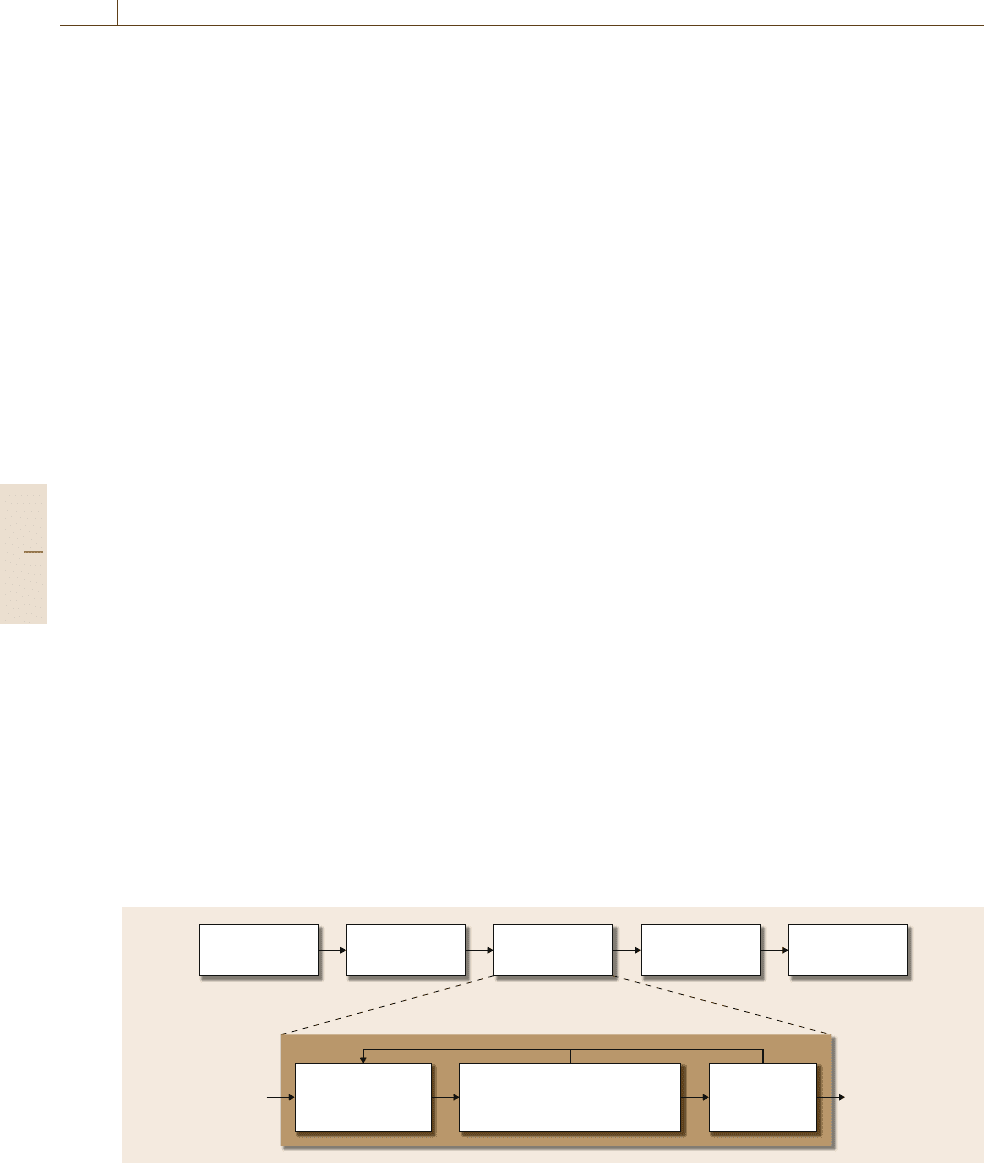
586 Part D Automation Design: Theory and Methods for Integration
•
During the definition phase, the system is decon-
structed into subfunctions and subsystems. Specifi-
cations are developed, in which all characteristics
and performance features as well as demands for
man and technology have to be included. Perfor-
mance is related to the system’s different phases of
use, e.g., operation and maintenance [34.37]. With
regard to the predetermined aspects, the layout and
evaluation of alternative solutions are developed for
each subsystem.
•
During the development phase, a detailed design of
the subsystem’s hardware and software is realized.
The developed solutions are integrated into a com-
plete functional system.
•
The acquisition phase comprises production of
the system’s hard- and software, testing of the
technical subsystem’s functionality, integration of
mechanical components, and production of user and
maintenance instructions. Furthermore, staff will be
included in this phase.
•
During the use phase, usage of the system is
realized. Operational experiences, which include
a normal, disturbed, and maintained operation, form
the basis for improvement, modernization, and re-
design of similar systems.
A review at the end of each phase decides upon the start
of the next phase, when the development project has
achieved a definite level of maturity.
Design Projects
The following design projects are exercised for each
phase of a man–machine system (Fig.34.9)
•
With the help of system analysis the general goals
for the complete system are determined, then the
problem is firmly established and detailed.
Forerunner
phase
Task analyses Evaluation
Technological/technical/
organizational/ergonomical
design
Definition
phase
Developing
phase
Aquisition
phase
Utilization
phase
Fig. 34.10 Phases of an automated system and their development project
•
Within the framework of the function analysis,the
system functions necessary to achieve the prede-
termined goals are established. The analyses of
individual functions and their allocation to the ma-
chine or to man is the task of the technological work
design.
•
The tasks for the human result from the assign-
ment of functions. Through a task analysis we have
to evaluate whether the function and its related
task can generally be conducted by the available
staff. A group of users has to be selected and
trained.
•
Technical, organizational, and ergonomic work de-
sign aims for optimal development of the system
components and work conditions through alignment
of the conditions to the user (Sect.34.1.1).
•
An evaluation helps to verify the efficiency of the
enforced design measurements for the implemented
system. In order to achieve system optimization, the
design methods have to be adjusted in case of goal
divergence.
Emphasis on Human-Oriented Design
Within the realm of the human-oriented design of
a man–machine system, the functions and components
with a high degree of interaction between men and ma-
chine [34.38] are the most important. When designing
partly automated systems or assisting systems, the fol-
lowing tasks are mainly affected:
•
Tasks for function division between man and ma-
chine as well as for structuringthe task given to man
(i.e., technical/technologicalor organizational work
design)
•
Tasks for optimization of integration of communi-
cation at the interface of man and machine (i. e.,
ergonomic design)
Part D 34.3

Integrated Human and Automation Systems 34.3 Design Rules for Automation 587
•
Tasks to increase job or machine safety (i.e., tech-
nical design) by including hazardous factors of the
work environment (e.g., noise, climate, vibrations).
Task-specific criteria and requirements of human-
oriented work design as well as methodical approaches
will be discussed in the following sections.
34.3.3 Function Division
and Work Structuring
Subfunctions of a work system can be achieved by man
and bya machine.If man is the center of interest,the de-
sign of the work system is geared towards the following
levels of evaluation of human work [34.39]:
•
Feasibility: anthropometrical, psychophysical, bio-
mechanical thresholds for brief workload duration
in order to prevent health damage
•
Tolerability: physiological and medical thresholds
for a long workload duration
•
Reasonability: sociological, group specific, and in-
dividual thresholds for a long workload duration
•
Satisfaction: individual sociopsychological thresh-
olds with long and short validity.
In manual assembly, for example the joining of parts,
certain thresholds result for the worker due to the re-
quired speed or accuracy of motions. Figure 34.11
presents this situation schematically.
Ergonomic optimization is desirable, if the com-
bination of stress parameters resulting from the work
task leads to tolerable work conditions (i.e., ergonomic
Satis-
fied?
Precision of movement
Speed of movement
Reasonable?
Automation
not possible
Ergonomical design
achievable and tolerable
Work structuring
achievable, not tolerable
Fig. 34.11 Dimensions of work design from an ergonomic
point of view [34.4]
design, see Sect. 34.1.1). If work can be done but
is not tolerable, mainly the content of the working
task has to be changed with the help of measure-
ments regarding work structuring (i. e., organizational
design, see Sect. 34.1.1). If the work task cannot be
fulfilled, automation (i.e., a technical/technological
design, see Sect.34.1.1) of the work system is recom-
mended, which implies extensive transfer of functions
to a machine.
Further influences on the design of systems result
from technical and economical requirements. Due to
the numerous influences on the design, it is impossi-
ble to distinguish specific design dimensions from each
other. In factories we can find work systems with dif-
ferent degrees of automation among which are obvious
combinations of manual and automated systems (hybrid
systems).
When assigning functions within the man–machine
system,thepsychologicalandphysiologicalperformance
requirements of the working man have to be taken into
consideration (Sect.34.1.8). In this way overextension
of the worker can be avoided and health damage can
be averted. Appropriate work structuring also takes into
consideration not giving the man solely leftover func-
tions, where he compensates or conducts nonautomated
functions. Function division and work structuring there-
fore have to be developed in such a way that interesting,
motivating, and diversified task arise [34.40] and opti-
mal system effectiveness is guaranteed.
34.3.4 Designing a Man–Machine Interface
A central task when developing human-oriented auto-
mated work systems is the design of the man–machine
interface. Ergonomically designed workplaces and ma-
chines – both in regard to hardware and software with
the corresponding desktop – contribute to user-friendly
and efficient task accomplishment.
Workplace
The workplace is the place where the task will be ac-
complished. At workplaces on the production level the
following problems often occur:
•
Inappropriate posture, forced posture due to limited
free space or awkward positioning of appliances
•
One-sided, repetitive movements
•
Inappropriate movement of arms and legs
•
Appliance of body forces.
In terms of ergonomic work design the demand arises to
adjust the workplace in regard to its dimensions, visual
Part D 34.3
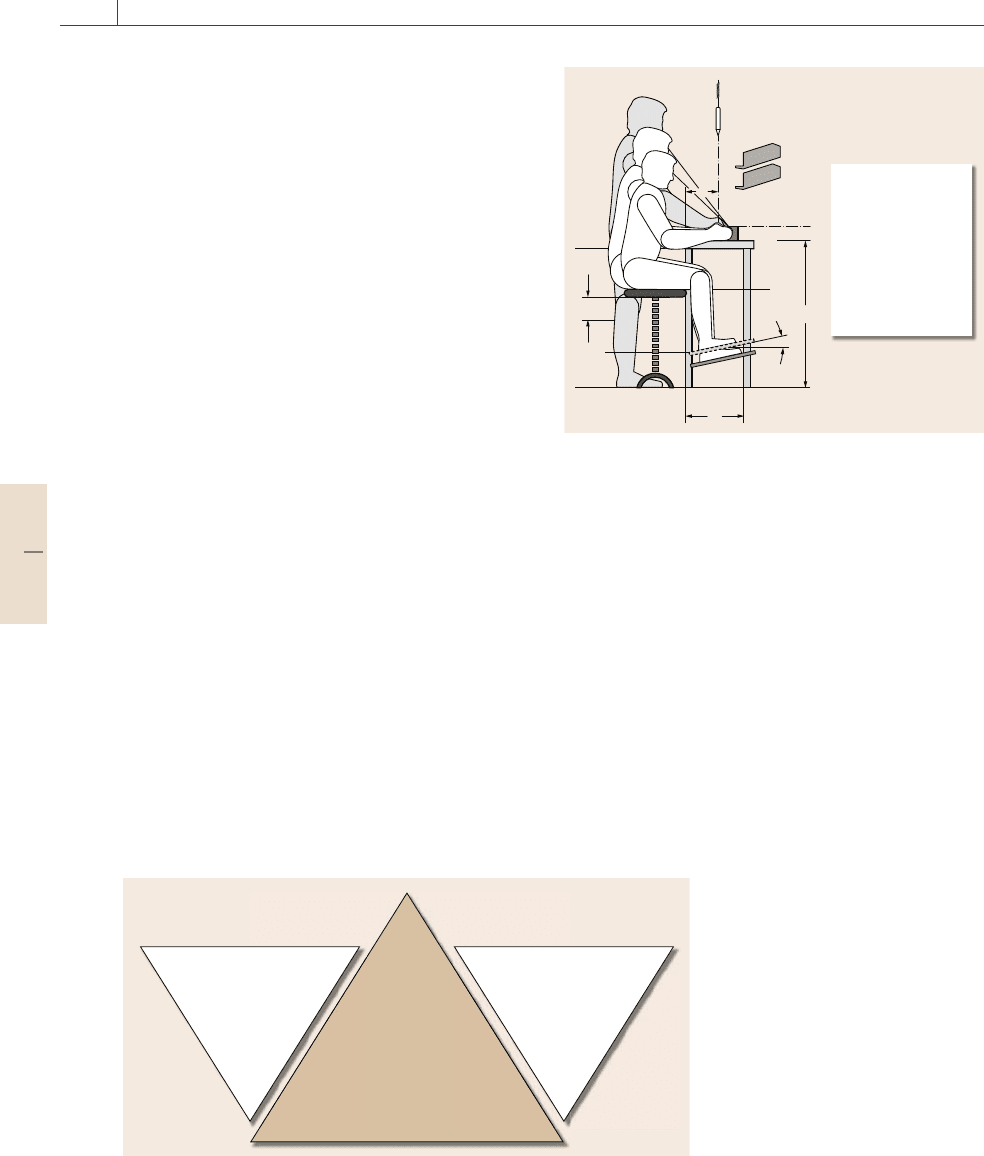
588 Part D Automation Design: Theory and Methods for Integration
and active area, and the forces that have to be applied
to the conditions of the working man. The starting point
for workplace design is the working task. Depending
on the working task, specific demands arise in regard
to motor functions and visual perception. The demands
of the working task have to match man’s performance
prerequisites. Figure 34.12 showsfactorsthathaveto
be taken into consideration when designing a work-
place. The technologies or materials that are used can
lead to further demands in regard to the configuration
of the workplace, for example, lighting, ventilation, and
storage.
Anthropometric Design of Workplaces. The starting
point for anthropometric design of workplaces is the
size of the human body. In order to prevent forced
posture, e.g., intense bending forward or to the side,
workplaces have to be aligned with the body size of the
workers who work at that particular place.
When discussing the anthropometric design of the
workplace, it has to be clarified whether work will take
place sitting or standing (Fig. 34.13). A balanced posi-
tion can be achieved by a change of posture. Basically
it is important to set the human body size in relation to
the correct distance between floor or feet height, work-
ing height, and seat height. The working height has to
be adjusted to the conditions of the work task. In ad-
dition it is important to have sufficient horizontal and
vertical space.
If severalpersons work at different times at the same
workplace (for example, shift work), the workplace has
to be equipped with appropriate adjustability in order to
be adjusted to different body shapes and heights.
Physiological Design of Workplaces. Physical strength
also has to be taken into consideration at automated
Human
One person / collective
Gender, age, nationality
Capabilities
Working task
Movement, force,
preciseness, frequency
Working tool
component
Work-
place
Sitting / standing
Order and measurement
of tools
Dimensions
(visual and active space)
climate, sound
Fig. 34.12 Factors for the design of
a workplace
a: height of
working space
b: height of the seat
e: distance of
working place
s: visual distance
α: foot rest incline
t: floor space depth
α
a
b
t
e
s
s
Fig. 34.13 Blueprint of a possible seat-standing workplace
workplaces, as the basis for lifting and carrying of loads
and operation of the system elements. Tasks that require
intensive body movements and a large amount of physi-
cal strength should be conducted in a standing position.
Tasks that require a high degree of preciseness (e.g.,
subtle assembly) and little physical strength can be con-
ducted while sitting. Information about the dimensions
of working tasks and their required physical strength is
given in ergonomic literature [34.1,5,41].
Anatomically Favorable Alignment of Working Tools.
Anatomically favorable alignment of appliances and
working tools avoids unnecessary movement and as-
sists balanced physical strain on the human body.
Figure 34.14 presents an example of how to align ap-
pliances in a partly automated workplace. Objects that
have to be grasped (bin with parts) are arranged within
Part D 34.3

Integrated Human and Automation Systems 34.3 Design Rules for Automation 589
Fig. 34.14 Partly automated manufacturing workplace
a reachable distance and the machine is positioned in
the center.
Design of VDU Workplaces. Most of the time automated
work in an office is performed at visual display units
(VDUs). In addition to the working postures already
mentioned above, the following factors have to be taken
into account when working at a VDU [34.43]:
•
Strain of the supporting apparatus or musculoskele-
tal system: Continuous, static sitting strains the
supporting apparatus and the musculoskeletal sys-
tem extremely and can lead to muscle tensions and
degeneration effects. Repetitive tasks such as data
entry can lead to pain in the wrist (for example,
repetitive strain injury) and chronic back pain.
•
Eyestrain: Frequent change of eye contact between
screen, draft, and keyboard (that is to say, accommo-
dation) and the resulting adjustment to the changing
light level (that is to say, adaptation) provoke enor-
mous strain on the eyes and can cause eye damage.
•
Psycho-mental strain: Man is stressed while carry-
ing out demanding informational tasks when being
exposed to (unintentional) interruptions, time pres-
sure, and fragmentation of the work task.
The demand to configure the daily work schedule with
a change of activities or regular breaks is very im-
portant for the human-oriented design of a workplace.
VDU tasks and other activities should be alternated
in order to avoid burden on the eyes and encourage
movement. If a change of activity cannot be realized,
regularly short breaks from work at the screen should
be included [34.27].
Man–Machine Communication
In the course of automation, interaction between man
and machine becomes an information exchange, i.e.,
man–machine communication. This information ex-
change is realized by man’s sensors (i.e., senses) and
actuating elements (i. e., effectors) on the one hand,
and input and display systems of the machine on the
other. This exchange of information is controlled by
the human or technical processing of the information.
Software ergonomic work design has the function of
designing input and display systems and the machine’s
processing of information according to ergonomic goals
(Sect.34.3.3). While so doing, the task and conditions
of the working environment are taken into account. Ad-
ditional tasks result from the selection and education of
users who operate these systems.
Sensory, cognitive, and motor characteristics have
to be taken into account when designing man–machine
communication. The visual channel (the eye) can be ad-
dressed via optical displays, the auditory channel (the
ear) via acoustic displays, and the tactile channel (sense
of touch) via haptic displays. As the hand and foot mo-
tor functions are available for the mechanical input after
processing of information by the brain (cognition), so
language is available for linguistic input. Now input
via body movement (gestures) also plays an impor-
tant role, for example, through the use of the mouse
or via the measurement of hand, head, and eye move-
ment (movement tracking). According to Fig.34.15,the
Processing of information
Dialogue control
Sensors Actuating elements
Display system Input system
Input and
display systems
Dialogue system
Assisting system
User modeling
Task modeling
Situation identification
Risk analysis
Technical functions
Man
Machine
Fig. 34.15 Levels of man–machine communication [34.42]
Part D 34.3

590 Part D Automation Design: Theory and Methods for Integration
design of man–machine communication can be repre-
sented at three levels:
•
The highest level shows the interface between man
and machine, the input and display systems, which
are often defined as the desktop.
•
The next level is the dialogue system, which creates
the connection between the input and display, and
which causes the machine’s control of information
flow.
•
The third level refers to the application of assisting
systems, which support the user when developing
processing strategies and system control.
The design of these levels has the goal of tuning the
technical system for the acceptance, processing, and
display of information for man and his tasks.
Input and Display Systems. The design of an input and
display system has to resolve three tasks [34.44]:
•
It has to choose appropriate design parameters ac-
cording to human conditions when adjusting the
system to the human’s motor function and sensors.
•
It has to display the information codes that are nec-
essary for exchange of information between man
and machine; in this case, compatibility has to be
taken into account.
•
The organization of information designs the input or
output of connected information.
Appropriate input systems are those that use human ca-
pabilities for the transmission of information: exercise
of body force on objects, gestures, mimics, talking, and
writing. Technical input systems are also useful if they
can absorb and interpret the provided information. The
best available technology allows the extended utiliza-
tion of the previously mentioned human capabilities by
using switches, levers, hand wheels, dials, keys, key-
boards (for example, work at the VDU), etc. Speech
recognition systems have seen immense progress, so
that the use of speech signal input can be realized, for
example, when entering numeric codes. Writinginput is
used with electronic notebooks.
When releasing information, visual, auditory, and
tactile kinesthetic sense modalities are addressed. Fur-
thermore, speech output is becoming increasingly
important. Haptic displays are mainly used to facili-
tate blind operation of switches. Due to the amount and
variability of the presented information and the optional
access options, optical displays – mostly in the form of
screens – play a dominant role. Multimedia forms of
communication connect the different forms of coding:
number, text, speech, and picture.
Compatibility of the design of (complex) input and
output display systems is extremely important. Com-
patibility can also be defined as the decoding process,
which the human has to achieve when evaluating the
different forms of information. Inner compatibility is
achieved when compatibility exists between man’s pe-
riphery and the inner models (i.e., associations and
stereotypes). A good example is the fact that one ex-
pects an increase in value when turning the adjusting
knob to the right. An outer compatibility is in place
when a display turns to the right according to the move-
ment of the operating element.
Dialogue Systems. Dialogue represents the interactive
exchange of information between man and machine
in order to achieve a task. Depending on the user’s
previous knowledge, different dialogue forms are pos-
sible: question–answer dialogue, form dialogue, menu
dialogue, key dialogue, command dialogue, and natu-
ral conversational dialogue. Dialogue forms as well as
a direct manipulation comprise concrete actions (for
example, display or sketching), pictures, and speech.
These demand less abstraction from the user than
text-based dialogues. There is always the possibil-
ity to adjust the dialogue system to a user-specific
demand.
Continuous technical progress leads to rapid in-
troduction of new program versions with dialogue
alternatives. In order to guarantee reliable utilization,
the user has to learn continuously. As printed instruc-
tion sheets are often ignored, integrated guidance of the
user in the dialogue is practical. This guidance should
be in line with the user’s learning progress and the as-
sisting and support systems, which the user can use in
the dialogue.
Assisting Systems. Man–machine communication is
generally designed as a dialogue, i.e., interaction be-
tween information input and output. Assisting systems
(or dialogue assistants) support the user during goal-
oriented use of a dialogue system by explaining the
system’s functions and user directions (Sect. 34.1.7). In
order to guarantee progress of the dialogue, datais taken
from the user (that is to say, user modeling), from the
task to be solved (that is to say, task modeling), and
from the present state of the system (that is to say,
situation identification). In so doing, the field of man–
machine communication comprises increasingly higher
levels of technical processing of information. Whereas
Part D 34.3
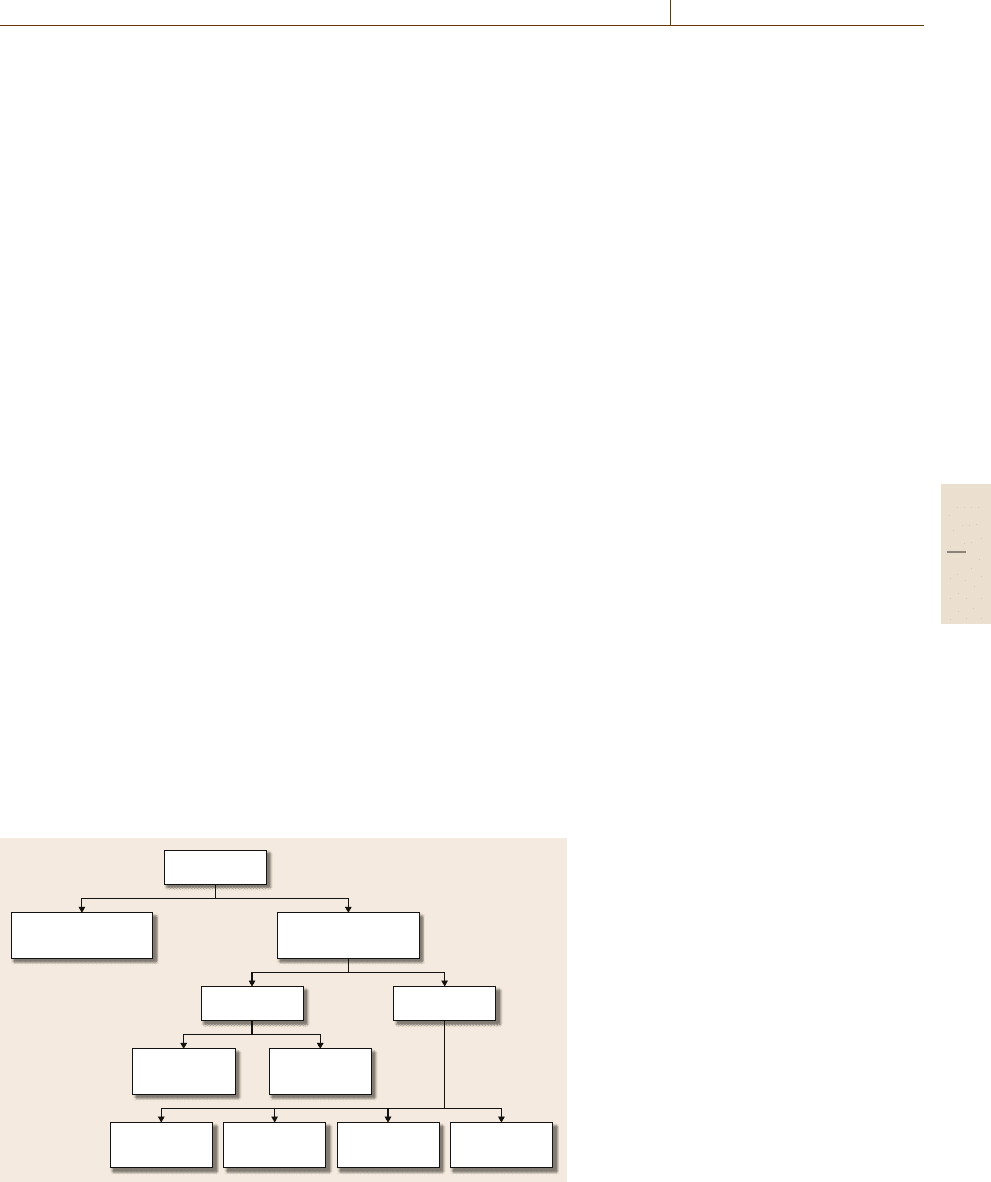
Integrated Human and Automation Systems 34.3 Design Rules for Automation 591
at the beginning only the desktop was affected in the
form of display and input elements, nowadays the entire
design of informational–technical systems are directed
to the user.
Principles of Design
for Man–Machine Communication
The design of man–machine communication mainly
comprises aspects of dialogue development and control
hierarchy.
Dialogue Development. Software ergonomic develop-
ment of man–machine communication is geared to-
wards the following demands for appropriate dialogue
development [34.45]:
•
Usability characterizes the degree to which a prod-
uct can be used effective, efficiently, and in a satis-
fying way.
•
Effectiveness determines the precision and com-
pleteness with which the user can achieve a certain
task goal. Errors can have a negative impact on
effectiveness. This is the case when the user is in-
capable of achieving the defined goal correctly or
completely.
•
Efficiency describes the cost-related effectiveness,
referring to the relation between the achieved pre-
cision and completeness of the effort used by the
user while attaining the goal. Deficiencies affect ef-
ficiency of utilization (fitness for use). The result is
correct, but the effort is inappropriate, as the user,
for example, can hardly avoid making mistakes.
•
Satisfaction is an indicator of the acceptance of uti-
lization.
Dialogue design
Functionality
(suitability for the task)
Usability
(suitability for learning)
Manipulation
Suitability for
individualization
Controllability
Orientation
ClearnessError toleranceCompatibility
Self-
descriptiveness
Fig. 34.16 Design principles of the
ISO 9241 standard for man–machine
communication
Central criteria for dialogue design are functionality
(i.e., the suitability of the task) and usability (i. e.,
suitability for learning). The ISO 9241 standard [34.3]
defines established principles for the design of man–
machine communication (Fig.34.16):
•
Suitability for the task: While working, the user
should experience support instead of interference or
unnecessary demands.
•
Self-descriptiveness: The dialogue should make it
clear what the user should do next.
•
Controllability: The user should be able to control
the pace and sequence of the interaction.
•
Compatibility, conformity with user expectations:
General experiences, schooling, experiences with
work processes or similar software are effectively
applicable. In terms of the expectation conformity,
boundaries of the technical system have to be trans-
parent (for example, safety functions).
•
Error tolerance: The dialogue should be forgiving.
In spite ofdefective input, theresult will beachieved
with only a few corrections.
•
Suitability for individualization: The dialogue sys-
tem allows adjustments to the demands of the
working task, to the user’s individual preferences,
and to the utilization capability.
•
Suitability for learning: The user will be supported
and instructed while learning the dialogue system.
Burmester [34.46] recommends a simple and clear
presentation of information, direct and unambiguous
language, direct feedback, as well as user-oriented ter-
minology for the implementation of design principles.
In order to design the utilization capability of the man–
Part D 34.3

592 Part D Automation Design: Theory and Methods for Integration
machine system more intuitively, known objects, for
example, office folders, are displayed on the software’s
desktop.
Control Hierarchy. The embedding of the dialogue sys-
tem intothe control hierarchy of a man–machine system
is as important as the dialogue design itself. Here we
have to clarify, if and how far the technical system is
allowed to limit man’s freedom to take decisions and
carry out actions. This question can be illustrated with
the help of the example of a driving assisting system,
which leads to increased safety for the driver when
maintaining an inappropriate distance to the preceding
vehicle and a reduction in speed.
Man’s capability to make a decision is dependent on
his position in the MMS. Decker [34.47] classifies three
different performance types:
•
Restitution performances: Here, the machine en-
ables a disabled human being to achieve standard
performances. Examples are prosthesis for ampu-
tated body limbs.
•
Expansion performances: Here, man achieves to-
gether with the machine a higher level of per-
formance than a standard performance. A good
example is a databank system, which simplifies the
data management and data organization.
•
Substitutionperformances: The performance,which
so far has been accomplished by man, is now
achieved by a machine supervised by man. An ex-
ample is the autopilot in a plane.
Experts are of the opinion that, as long as it is not pos-
sible to completely substitute man by a machine, man
should have the highest level of decision making in
a man–machine environment [34.48]. This implies that
man will have the final decision. In this way, man can
correct the MMS in case of errors.
The following problem appears however with partly
automated MMS: During long working phases of un-
interrupted automated production, man is permanently
unchallenged and easily fatigued. If man then actually
has to interfere due to a breakdown of the automated
system, the once unchallenging situations transforms
into a too challenging one. Consequently, we should
aim for a continuous activity level, in order to guarantee
manual takeover of the controlling system. Moreover,
redundancy should assure that the entire system is
reliable.
34.3.5 Increase of Occupational Safety
Automation of working systems needs to take into
account occupational safety. Occupational safety is
a necessary requirement for work processing. Safe
working conditions should minimize or even prevent
health damage to the working man. Generally speak-
ing, the work result cannot be guaranteed if unsafe work
conditions exist. A high level of safety is guaranteed
by measures of machine safety. Occupational safety
comprises safety measures and rules of conduct, which
should provide the user of technical systems with the
highest protection possible.
Automation measures basically reduce the haz-
ardous risks to the worker. However, when breakdowns
occur, the untrained worker has to interfere under time
pressure, which can cause new danger situations.
The design of a man–machine interface with an ab-
stract representation of information between user and
system, and that also screens mechanical noises and
vibrations, results in the risk that man’s contact with
reality is weakened. It has been observed that some
drivers compensate for safety gained through assisting
systems by changing to a risky driving style [34.49]. As
a result we can state that the demand for increased oc-
cupational safety always has to be seen in the context of
system reliability.
System Reliability
The term system reliability defines the probability that
the system works without any errors in a defined
timeframe. An error can be defined as an intolerable
divergence from a defined level of quality. Human re-
liability describes man’s capability to accomplish a task
in an acceptable way under fixed conditions within
a defined time frame. Here a basic difference between
human and technical reliability becomes visible: man
works in a goal-oriented manner, whereas the machine
works in a functional way. Man is able to control his
actions autonomously. Human errors do not usually
lead to an immediate breakdown, but can be corrected
before they negatively affect system operations. The
technical design of systems should assure the reliabil-
ity of the machine and its components through optimal
construction and selection of appropriate materials. Hu-
man reliability can be increased by rapid identification
of errors by the technical system and a supporting
decision-making process. Man is able to recognize and
correct for his own errors prior to their interference with
Part D 34.3
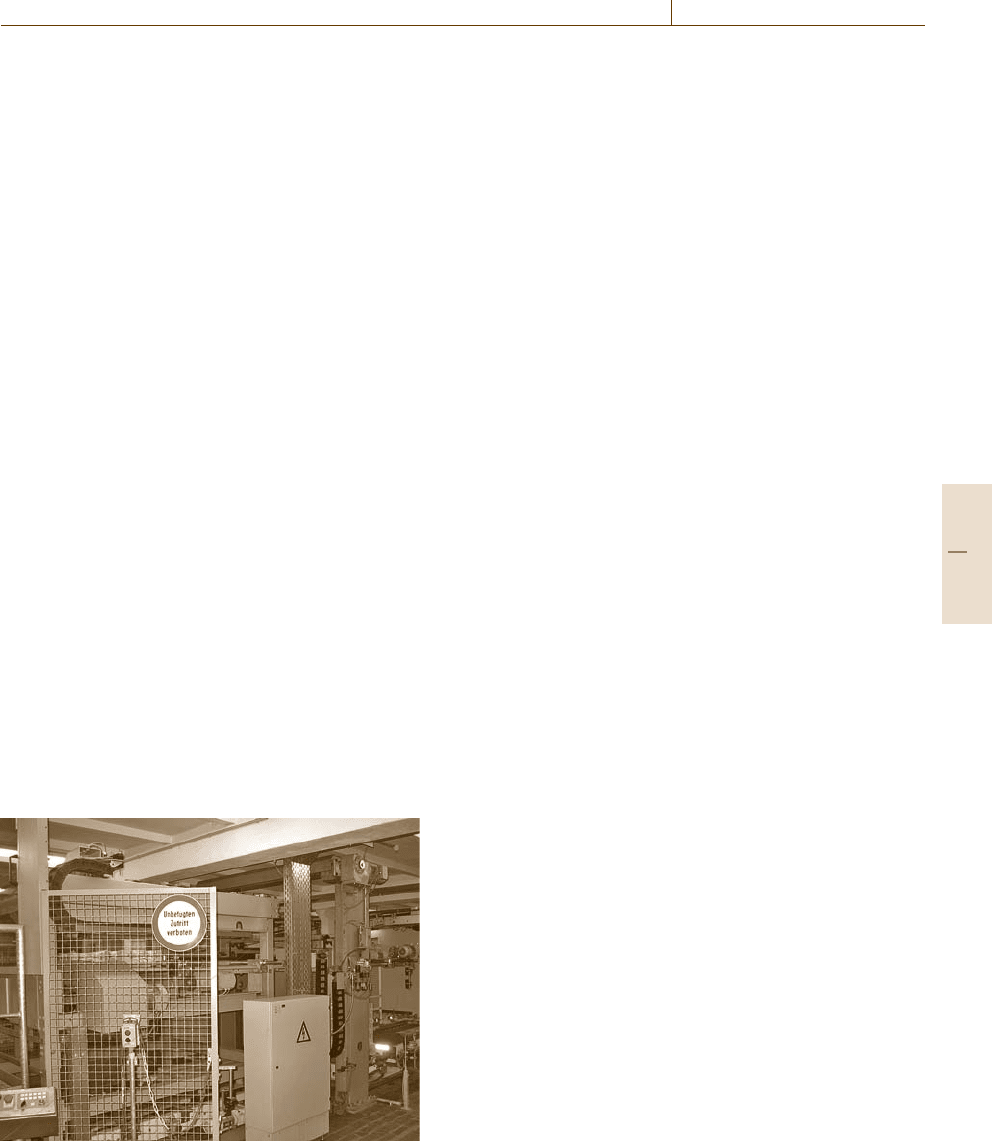
Integrated Human and Automation Systems 34.3 Design Rules for Automation 593
the system. He can also stop processes that seem to be
becoming problematic [34.50].
Design for Safety
Design Strategies. Adequate actions can contribute to
an increase in the safety level of automated working
systems and minimization of hazardous risks. The fol-
lowing kinds of risks have to be taken into account:
•
Hazardous risks linked to theutilization of thework-
ing tool
•
Hazardous risks that emerge at the workplace due to
interaction of the working tools with each other
•
Hazardous risks caused by the working materials or
the working environment.
Here we have to conduct a risk analysis of the work-
ing tool at the predetermined workplace. We have to set
this analysis in relation to other working mediums and
take all operating conditions (i.e., normal mode, mal-
function mode, and reconnection) into consideration.
The following rules have to be followed when de-
signing for safety [34.43]:
•
Elimination or minimization of hazardous risks
(i.e., indirect measures, for example, integration of
a safety concept when developing or constructing
a machine)
•
Implementing safety measures against risks that
cannot be eliminated (i.e., indirect measures)
•
Supply of information to users about remaining
risks due to the incomplete effectiveness of the im-
plemented safety measures; indication of eventual
Fig. 34.17 Disjunctive safety device at a palletizing
automaton
necessary special training and personal protection
equipment (i.e., information measures).
Risk Minimization of Mechanical Hazards. Mechan-
ical hazards are, for example, objects that fall or slide
out, dangerous surfaces and forms, moveable parts,
instability or material failure. Appropriate protective
measures have to been chosen for risk minimization of
mechanical hazards. Here we have to differentiate be-
tween inherently safe construction and technical safety
measures.
Inherently safe construction minimizes or elimi-
nates risks through an adequate design. Examples of
inherently safe constructions are the following:
•
Avoidance of sharp edges
•
Consideration of geometric and physicalfactors (for
example, limitation of amount, speed, energy, and
noise)
•
Electrical supply of energy at extra-low voltage.
Technical safety measures should be used when the in-
herently safe constructions are not sufficient enough.
Technical safety measures differ between disjunctive
and nondisjunctive appliances [34.51].
A separating safety device is part of a machine
which is used as a special kind of bodily shield
(Fig.34.17). Depending on its construction, a separat-
ing safety measure can be a cabinet, cover, shield, door,
casing, etc. The following two devices are examples of
separating safety devices [34.40]:
•
Fixed separating safety device: Theseare eitherlast-
ing (for example welded) or fixed to the machine
with thehelp ofelements (for example, abolt). They
block access to a dangerous area.
•
Movable separating safety device: These are mostly
mechanical in nature and connected to the machine
(by hinges, for example). They can be opened even
without the utilization of tools. A touch-sensitive
switch prevents the execution of dangerous machine
functions while the safety device is open.
The physical barrier between man and the hazardous
machine function is absent in the case of a nonsepa-
rating safety device. The worker will be recognized as
soon as he enters or reaches into the danger area. As
soon as the worker is recognized, the existing risk is
minimized or eliminated. We can differentiate between
the following nonseparable safety devices:
•
Control device with automatic reset device: Control
devicesthat start and maintain operation of mechan-
Part D 34.3
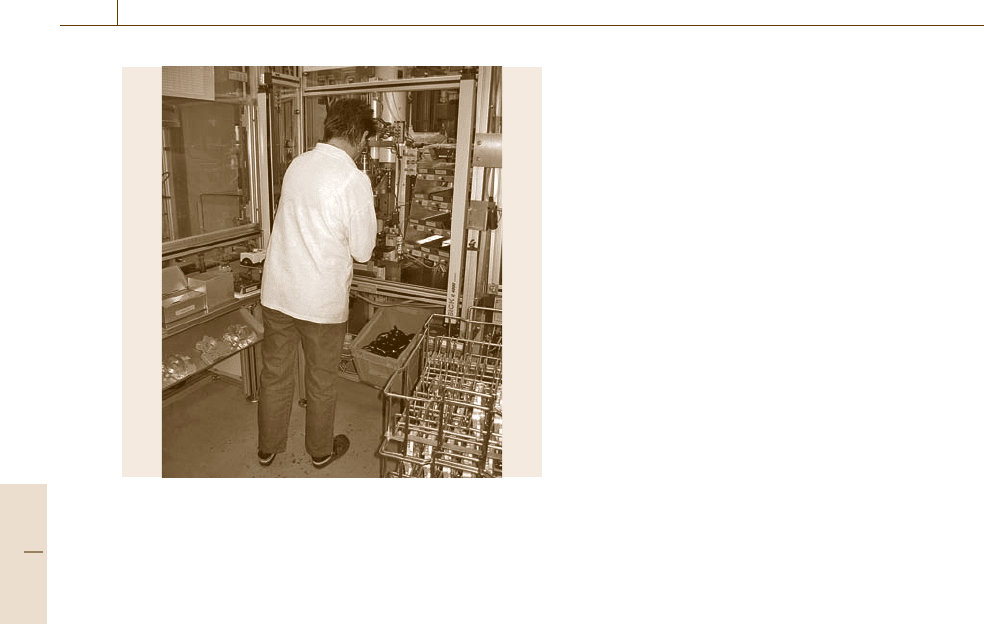
594 Part D Automation Design: Theory and Methods for Integration
Fig. 34.18 Safety measure with approximation function
(light barrier) at a partly automated assembly area
ical parts only as long as a hand control or operating
element is actuated. Examples are hand drills and an
edge grinder:
•
Two-hand coupling: Control devices that demands
the use of both hands at the same time in order to
start or maintain the machine’s functions.
•
Protective device with approximation function: De-
vices that stop hazardous mechanical parts as soon
as a person or a part of the human body crosses
a well-defined boundary (for example, light barrier,
see Fig.34.18).
Man–Machine Interface. Switches for the operation
mode and the removal of the energy supply are ap-
plied when designing a safe man–machine-interface
(Sect.34.1.3). Consequently, we find the following spe-
cific design features:
•
Switch for operation mode: Machines have to be re-
liably stopped in all functions or safety levels (for
example, maintenance, inspection).
•
Energy supply: The spontaneous restart of a ma-
chine after a breakdown of energy supply has to be
avoided, if this implies danger to the worker.
When designing a man–machine interface for safety,
displays have to be adjusted to human perceptive senses
so that relevant signals, warnings or information can
be quickly and reliably noticed. In order to evaluate
a situation, man allocates the role of key elements
to a multiplicity of sensations. These key elements
are incorporated into superior strategies. If complex
information is arranged in functional groups, decision-
making processes will be accomplished in a better way.
Man, for example, recognizes qualitative changes of
process parameters faster and is also able to assess them
better if they are presented in graphical patterns. The
combination of graphical elements producesa pattern in
which changes can be recognizedright away. In the case
of a change in the pattern, man can selectively change
to the next deeper level of information processing, in
which detailed information about the situationand other
characteristics relevant to the decision such as quantita-
tive measures is available. A superior graphical model
functions as an early warning system.
34.4 Emerging Trends and Prospects for Automation
34.4.1 Innovative Systems
and Their Application
In the light of technical innovation it can be expected
that automation of the value-creation processes will in-
crease in all branches and application areas. When used
adequately, automation can contribute to the improve-
ment of product quality, the increase of productivity,
and the enhancement of quality of work [34.52]. With-
out automation technology, some fields of human work
would not be accomplishable. Theoperation ofcomplex
control systems in modern aircrafts may exemplify this
circumstance.
With thehelp of efficient methods and procedures of
automation technology, new systems and products can
be obtained. Flexible automation, rather then the high-
est degree of automation, is the aim. Characteristics of
these systems and products are increasing complexity
and decentralization, a higher degree of cross-linking,
and dynamic behavior. However, they are only control-
lable with the help of automated appliances. Example
products can be found in the field of mechatronics. As
well as in the traditional application areas in the field
of process and production automation, automated solu-
tions are also frequently used in the service industries,
maintenance areas, and the field of leisure activities
Part D 34.4
